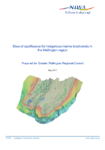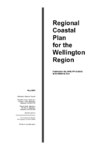The Wellington Coastal marine area is more than 500 km long, extends 12 nautical miles offshore, and supports a wide range of coastal habitats including estuaries, dunes, rocky reefs, undersea mountains, biogenic reefs, and methane seeps, which all play a unique role in our coastal ecosystems and are home to a wide range of indigenous species, many of which are rare within the region. These include seagrass, horse mussel, and Adamsiella algal beds, and sea anemone meadows.
The coastal areas in our region are not only of great ecological importance, but are also highly valued by our communities for cultural practices and recreational activities. They also provide ‘ecosystem services’ such as nursery habitat for juvenile fish, stabilising sediment, nutrient recycling, trapping carbon, and protecting our coastlines from erosion. Coastal areas provide a buffer between the land and sea, which is important for protection and resilience of our communities. These sites also support a range of native land animals and plants, and provide important nesting sites, rest spots, and areas to forage.
Our coastal habitats are ‘receiving environments’ for freshwater flowing from rivers and estuaries making them vulnerable to the effects of human activity such as litter, beach driving, dog walking, fishing, and harvesting. They are also susceptible to the effects of nearby activities such as sewage leaks, contamination from storm water and landfills, and sedimentation from housing development and rural activities such as farming and forestry.
Sites of significance for indigenous marine biodiversity in the Wellington region

Regional councils have specific management responsibilities over coastal waters and habitats which lie within New Zealand’s territorial seas out to 12 nm offshore. This responsibility has been expressed in the… Read more here

date_range Published 01 May 2012
Download now (PDF 3.4 MB) get_appThe Regional Coastal Plan
The Regional Coastal Plan applies to the coastal marine area of the Wellington region. The coastal marine area is the foreshore, seabed, coastal water, and the air space above the water, between the outer limits of the territorial sea and the line of mean high water springs.
The Plan identifies issues within the coastal marine area and outlines objectives, policies and methods to guide sustainable management.
Regional Coastal Plan for the Wellington Region

This Plan is operative within the coastal marine area of the Wellington Region. The outer or seaward boundary is the outer boundary of the Wellington Region as defined in SO35951.… Read more here

date_range Published 01 Apr 2011
Download now (PDF 628 KB) get_appCoastal monitoring
We monitor water quality, sediment quality, and invertebrate health in a number of estuaries, harbours, sandy beaches and rocky shores to assess environmental health, and increase our understanding of marine ecosystems in the Wellington Region. This allows us to focus on the improvement of areas that are showing signs of environmental stress through recommendation of targeted management practices.
Read more about our coastal monitoring
Dune care groups
Coastal dune systems provide habitat and sheltered breeding grounds for seabirds, native reptiles and invertebrates.
Many of the dunes along our coast are under threat due to modification by weeds and pests, coastal development, farming, sea level rise, and shrinkage due to limited space available for landward dune migration. There are a number of community groups in our area that are helping to restore these ecosystems through native planting and weed control.
Get in touch
- Phone:
- 0800496734
- Email:
- info@gw.govt.nz
